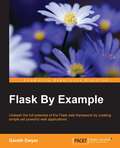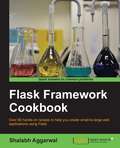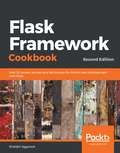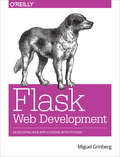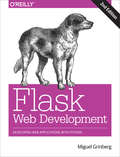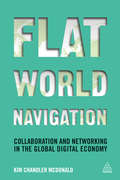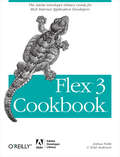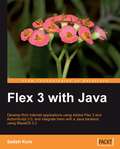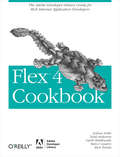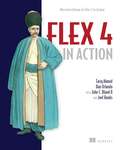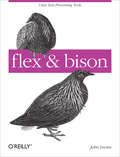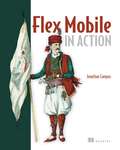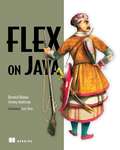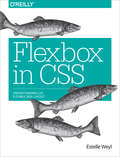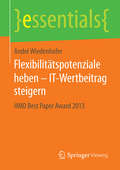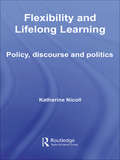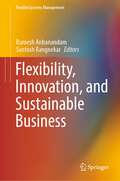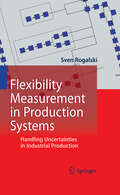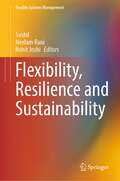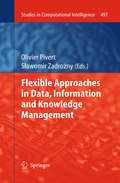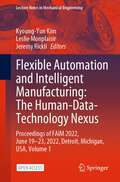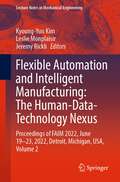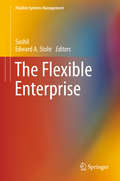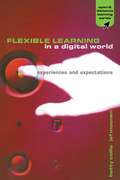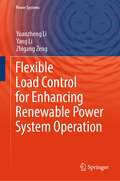- Table View
- List View
Flask By Example
by Gareth DwyerUnleash the full potential of the Flask web framework by creating simple yet powerful web applications About This Book * The most up-to-date book on Flask on the market * Create your own world-class applications and master the art of Flask by unravelling its enigma through this journey * This step-by-step tutorial is packed with examples on blending different technologies with Flask to get you up and running Who This Book Is For Have you looked at PHP and hated the clunky bloated syntax? Or looked at .Net and wished it was more open and flexible? Maybe you've tried your hand at GUI libraries in Python and found them hard to use? If your answer to any one of these questions is a yes, then this is just the book for you. It is also intended for people who know the basics of Python and want to learn how to use it to build powerful solutions with a web front-end. What You Will Learn * Build three web applications from the ground up using the powerful Python micro framework, Flask. * Dynamically display data to your viewers, based on their requests * Store user and static data in SQL and NoSQL databases and use this data to power your web applications * Create a good user experience by combining HTML, CSS, and JavaScript * Harness the convenience of freely available APIs, including OpenWeatherMap, Open Exchange Rates, and bitly * Extend your applications to build advanced functionality, such as a user account control system using Flask-Login * Learn about web application security and defend against common attacks, such as SQL injection and XSS In Detail This book will take you on a journey from learning about web development using Flask to building fully functional web applications. In the first major project, we develop a dynamic Headlines application that displays the latest news headlines along with up-to-date currency and weather information. In project two, we build a Crime Map application that is backed by a MySQL database, allowing users to submit information on and the location of crimes in order to plot danger zones and other crime trends within an area. In the final project, we combine Flask with more modern technologies, such as Twitter's Bootstrap and the NoSQL database MongoDB, to create a Waiter Caller application that allows restaurant patrons to easily call a waiter to their table. This pragmatic tutorial will keep you engaged as you learn the crux of Flask by working on challenging real-world applications. Style and approach This book will provide you with rich, practical experience of Flask. Every technology, that is employed along with Flask is comprehensively introduced, while the book focusses on developing web applications. Pointers to educational material are always given if you want to gain in-depth knowledge of the various technologies used.
Flask Framework Cookbook
by Shalabh AggarwalIf you are a web developer who wants to learn more about developing applications in Flask and scale them with industry-standard practices, this is the book for you. This book will also act as a handy tool if you are aware of Flask's major extensions and want to make the best use of them. It is assumed that you have knowledge of Python and a basic understanding of Flask. If you are completely new to Flask, reading the book from the first chapter and going forward will help in getting acquainted with Flask as you go ahead.
Flask Framework Cookbook: Over 80 proven recipes and techniques for Python web development with Flask, 2nd Edition
by Shalabh AggarwalBuild state-of-the-art web applications quickly and efficiently using Flask and related technologies with Python 3 Key Features Updated to Flask 1.0.3 and Python 3.7 with coverage of Microservices Get the most out of the powerful Flask framework and maintain the flexibility of your design choices Write cleaner and maintainable code with the help of sample apps Book Description Flask, the lightweight Python web framework, is popular due to its powerful modular design that lets you build scalable web apps. With this recipe-based guide, you'll explore modern solutions and best practices for Flask web development. Updated to the latest version of Flask and Python 3, this second edition of Flask Framework Cookbook moves away from some of the old and obsolete libraries and introduces recipes on bleeding edge technologies. You'll discover different ways of using Flask to create, deploy, and manage microservices. This Flask Python book starts by covering the different configurations that a Flask application can make use of, and then helps you work with templates and learn about the ORM and view layers. You'll also be able to write an admin interface and get to grips with debugging and logging errors. Finally, you'll grasp a variety of deployment and post-deployment techniques for platforms such as Apache, Tornado, and Heroku. By the end of this book, you'll have gained all the knowledge you need to write Flask applications in the best possible way and scale them using standard industry practices. What you will learn Explore web application development in Flask, right from installation to post-deployment stages Make use of advanced templating and data modeling techniques Discover effective debugging, logging, and error handling techniques in Flask Integrate Flask with different technologies such as Redis, Sentry, and MongoDB Deploy and package Flask applications with Docker and Kubernetes Design scalable microservice architecture using AWS LambdaContinuous integration and Continuous deployment Who this book is for If you are a web developer who wants to learn more about developing scalable and production-ready applications in Flask, this is the book for you. You'll also find this book useful if you are already aware of Flask's major extensions and want to use them for better application development. Basic Python programming experience along with basic understanding of Flask is assumed.
Flask Web Development
by Miguel GrinbergTake full creative control of your web applications with Flask, the Python-based microframework. With this hands-on book, you'll learn Flask from the ground up by developing a complete social blogging application step-by-step. Author Miguel Grinberg walks you through the framework's core functionality, and shows you how to extend applications with advanced web techniques such as database migration and web service communication.Rather than impose development guidelines as other frameworks do, Flask leaves the business of extensions up to you. If you have Python experience, this book shows you how to take advantage of that creative freedom.Learn Flask's basic application structure and write an example appWork with must-have components--templates, databases, web forms, and email supportUse packages and modules to structure a large application that scalesImplement user authentication, roles, and profilesBuild a blogging feature by reusing templates, paginating item lists, and working with rich textUse a Flask-based RESTful API to expose app functionality to smartphones, tablets, and other third-party clientsLearn how to run unit tests and enhance application performanceExplore options for deploying your web app to a production server
Flask Web Development: Developing Web Applications with Python
by Miguel GrinbergTake full creative control of your web applications with Flask, the Python-based microframework. With the second edition of this hands-on book, you’ll learn the framework from the ground up by developing, step-by-step, a real-world project created by author Miguel Grinberg. This refreshed edition accounts for important technology changes that have occurred in the past three years.You’ll learn the framework’s core functionality, as well as how to extend applications with advanced web techniques such as database migration and web service communication. The first part of each chapter provides you with reference and background for the topic in question, while the second part guides you though a hands-on implementation of the topic.If you have Python experience, this book shows you how to take advantage of the creative freedom Flask provides.
Flat World Navigation
by Kim Chandler McdonaldFlat World Navigation introduces the new future of work in the 'flattened world' of the new digital attention-based economy, where real connections can be made in seconds across departments, businesses, cultures and countries. Combining the best elements of networking, social media outreach and collaborative techniques, flat world navigation is an essential capability to build and maintain relationships between colleagues, customers and partners. Employees who can transform themselves into flat world navigators, experts in mediating these powerful relationships and bringing the customer into the conversation, will mean the difference between success and failure in business. Flat World Navigation includes exclusive insights and interviews with international business leaders who successfully use flat world navigation skills, such as the Emmy-winning former NBC and Wall Street Journal reporter Kare Anderson, Sandy Carter at IBM, Gordon Feller at CISCO Systems, Aria Finger at DoSomething.org, Louise Guido at ChangeCorp, Jeffrey A. Finkle at the International Economic Development Council and Carolyn Lawrence, CEO of Women of Influence. This book is grounded in real-world experience with insights and advice to build your skills base and empower the next generation of business people. Additionally, it is of great use to business owners and managers looking to effectively leverage the skills of these flat world navigators, whose critical role brings attention to ideas, products and services and, as such, must be part of a successful business strategy.
Flex 3 Cookbook: Code-Recipes, Tips, and Tricks for RIA Developers (Adobe Developer Library)
by Joshua Noble Todd AndersonThe best way to showcase a powerful new technology is to demonstrate its real-world results, and that's exactly what this new Cookbook does with Adobe Flex 3. Wide ranging and highly practical, Flex 3 Cookbook contains more than 300 proven recipes for developing interactive Rich Internet Applications and Web 2.0 sites. You'll find everything from Flex basics, to solutions for working with visual components and data access, to tips on application development, unit testing, and using Adobe AIR. You also get ideas from the development community. Through its Flex Cookbook website (www.adobe.com/devnet/), Adobe invited Flex developers to post their own solutions for working with this technology, and from hundreds of posts, the authors chose the best and most useful solutions to supplement Flex 3 Cookbook. Each recipe inside provides a solution to a common problem, explains how and why it works, and offers sample code that you can put to use immediately. Topics include:Containers and dialogues Working with Text Data driven components DataGrid and Advanced DataGrid ItemRenderers and Editors Images, bitmaps, videos, and sounds CSS, styling, and skinning States and effects Working with Collections, arrays, and DataProviders Using DataBinding Validation, formatting, and regular expressions Using Charts and data visualization Services and Data Access Using RSLs and Modules Working with Adobe AIR Whether you're a committed Flex developer or still evaluating the technology, you'll discover how to get quick results with Flex 3 using the recipes in this Cookbook. It's an ideal way to jumpstart your next web application.
Flex 3 with Java
by Satish KoreThe author's experience in creating applications using Flex enables him to share insights on using it effectively in a clear, simple, and concise manner. His approach will help you gain hands-on programming experience in Flex 3 and ActionScript 3.0. The book focuses on important features of Flex 3 and ActionScript 3.0 and gives clear instructions and precise code examples to explain features and ensure that you actually learn as you read. This book is a good starting point for any developer with a little experience in Java programming to get going with Adobe Flex 3 and ActionScript 3.0 development. You may be a software developer/professional who wishes to learn and understand Flex 3 technology for developing Rich Internet Applications. If you are a system analyst who wants to explore and understand Flex 3 then this is an ideal book for you.
Flex 4 Cookbook: Real-world recipes for developing Rich Internet Applications
by Joshua Noble Todd Anderson Rich Tretola Marco Casario Garth BraithwaiteWith this collection of proven recipes, you have the ideal problem-solving guide for developing interactive Rich Internet Applications on the Adobe Flash Platform. You'll find answers to hundreds of common problems you may encounter when using Adobe Flex, Flex 4 Framework, or Flash Builder, Adobe's GUI-based development tool. Flex 4 Cookbook has hands-on recipes for everything from Flex basics to solutions for working with visual components and data access, as well as tips on application development, unit testing, and Adobe AIR. Each recipe provides an explanation of how and why it works, and includes sample code that you can use immediately. You'll get results fast, whether you're a committed Flex developer or still evaluating the technology. It's a great way to jumpstart your next web application. Topics include: Using Spark Component Text Layout Framework Groups and Layout Spark List and ItemRenderer Images, bitmaps, videos, and sounds CSS, styling, and skinning States and Effects Working with Collections Using DataBinding Validation, formatting, and regular expressions Using Charts Services and Data Access Using RSLs and Modules Working with Adobe AIR 2.0
Flex 4 in Action: Revised Edition Of Flex 3 In Action
by Dan Orlando Joel Hooks Tariq AhmedFlex 4 in Action is an easy-to-follow, hands-on Flex 4 tutorial. Revised and updated from the previous edition on Flex 3, this book is chock-full of examples, goes beyond feature coverage, and helps readers put Flex to work in real day-to-day tasks. This book helps Flex developers make their Flex applications stand out from the crowd. How comprehensive is Flex 4 in Action?Interesting themes, styles, and skins? It's in there.Working with databases? You got it.Interactive forms and validation? You bet.Charting techniques to help you visualize data? Bam!Many Flex books are overwhelming to new users-focusing on the complexities of the language and super-specialized subjects in the Flex ecosystem. Flex 4 in Action filters out the noise and dives into the core topics users need every day. Using numerous easy-to-understand examples, Flex 4 in Action provides a strong foundation that readers can build on as the complexity of their projects increases. Purchase of the print book comes with an offer of a free PDF, ePub, and Kindle eBook from Manning. Also available is all code from the book.
flex & bison: Text Processing Tools
by John LevineIf you need to parse or process text data in Linux or Unix, this useful book explains how to use flex and bison to solve your problems quickly. flex & bison is the long-awaited sequel to the classic O'Reilly book, lex & yacc. In the nearly two decades since the original book was published, the flex and bison utilities have proven to be more reliable and more powerful than the original Unix tools. flex & bison covers the same core functionality vital to Linux and Unix program development, along with several important new topics. You'll find revised tutorials for novices and references for advanced users, as well as an explanation of each utility's basic usage and simple, standalone applications you can create with them. With flex & bison, you'll discover the wide range of uses these flexible tools offer.Address syntax crunching that regular expressions tools can't handle Build compilers and interpreters, and handle a wide range of text processing functions Interpret code, configuration files, or any other structured format Learn key programming techniques, including abstract syntax trees and symbol tables Implement a full SQL grammar-with complete sample code Use new features such as pure (reentrant) lexers and parsers, powerful GLR parsers, and interfaces to C++
Flex Mobile in Action
by Jonathan CamposWith constant innovation on the iOS, Android, and BlackBerry platforms, the mobile device landscape is complicated and changing rapidly. Adobe leads the way with Flex Mobile, a new technology that provides a single development environment that exports applications to any mobile platform, eliminating the need to write and re-write code.Flex Mobile in Action teaches how to use the powerful Flex Platform to create compelling mobile applications that can stretch across Apple iOS, Android, and BlackBerry devices. It contains practical application development techniques such as accessing native device capabilities, choosing the right architectural patterns, and building data access models. It also covers the new Flex 4.6 with Flash Builder which builds on Flex 4.5 for the creation of outstanding mobile applications.
Flex on Java
by Bernerd Allmon Jeremy AndersonUnlike many Flex books that presume readers want to develop applications from scratch, Flex on Java is for developers in the real world-where Flex is one more technology being added to existing systems developed in Java, and where integration is the key indicator of success.Written for Java developers beginning to use Flex, Flex on Java shows how to use Flex alongside existing Java applications, and how to integrate Flex using familiar server-side technologies such as Spring, EJBs, JMS, and more. The authors, both Agile development experts, focus on Agile and test-driven development to enable readers to redesign applications that deliver more value and with zero defects. Throughout the book, readers will apply these techniques to refactoring a single application into a rich internet application using Flex and the BlazeDS framework. Purchase of the print book comes with an offer of a free PDF, ePub, and Kindle eBook from Manning. Also available is all code from the book.
Flexbox in CSS
by Estelle WeylLayout designers rejoice: CSS finally has an update that will make your lives easier. Flexible box layout, often called Flexbox, frees you from the challenges of creating layouts with floats and padding? and lets you specify containers and their contents instead. The new model means you can specify the directions in which material flows, how content wraps, and the ways components can expand to fill a space. Whether you've been creating large sites or small, fixed sites or responsive sites, flexbox will simplify your work.
Flexibilitätspotenziale heben - IT-Wertbeitrag steigern: HMD Best Paper Award 2013 (essentials)
by André WiedenhoferIn den vergangenen Jahren nahm die Veränderungsgeschwindigkeit in den Unternehmen stetig zu. Die wachsende Globalisierung, die Auswirkungen der Krise und die rasch wandelnden Technologien haben bewährte Geschäftsmodelle grundlegend in Frage gestellt. Die ständige Anpassung wird ,,business as usual". Dadurch bedingt ändern sich die Anforderungen an die betriebliche Informationstechnologie (IT). Um einen wesentlichen Wertbeitrag zu generieren, muss die IT der marktinduzierten Unsicherheit mit einem angemessenen Grad an Flexibilität begegnen. In Anlehnung an die ressourcenorientierte Theorie stellt André Wiedenhofer die IT als wesentliche Kernkompetenz dar. Da Unsicherheit in der Literatur bisher kaum Beachtung gefunden hat und Flexibilitätspotenziale scheinbar noch nicht ausgeschöpft sind, soll der Beitrag Handlungsempfehlungen geben, wie die IT langfristig ihren Wertbeitrag organisatorisch verbessern kann.
Flexibility and Lifelong Learning: Policy, Discourse, Politics
by Katherine NicollWhat can the politics of discourse tell us about the discourse of politics? How are flexibility and lifelong learning positioned within policy? Flexibility and lifelong learning have become key aspects of education policy in nation states and bodies such as the European Union and Organisation of Economic Cooperation and Development in recent years. They are positioned as necessary for the knowledge economy and social inclusion. The failure to adapt through becoming more flexible and participating in lifelong learning is held up as a failure at individual, organisational and national levels. But how has that narrative come to be constructed? In what ways is it persuasive? And what forms of political action are possible and necessary? These are the questions addressed in this text. Drawing upon the work of Michel Foucault and on the notion of rhetoric, this book forensically explores examples of the work of policy texts in the discourses of education, lifelong learning and flexibility that they construct. In so doing, it argues for the need to take policy discourse seriously and not simply dismiss it as ‘spin’. Through a detailed examination of policy texts from primarily Australia, the UK and European Union, this text provides insights into the strategies through which flexibility and lifelong learning become realized and realizable as part of the common sense of educational discourse. Rather than simply rejecting these ideas, or suggesting they are merely the window dressing for the more malign interests of the knowledge economy or globalization, it suggests a politics of the wedge and possibilities for the insertion of different meanings. Central to the claims of this text are that we need to engage closely with the discursive and rhetorical strategies of policy, in order that we understand both how it is constructed and thus how it can be deconstructed.
Flexibility, Innovation, and Sustainable Business (Flexible Systems Management)
by Ramesh Anbanandam Santosh RangnekarThis book contains practical experiences, knowledge, and insights in the evolution, formulation, and implementation of strategies and models for flexibility, innovation, and sustainable business. The book discussed the increasing significance of a flexible approach by businesses as much as possible in every area of their work—from employment policies to supply chain management (SCM). It further links this flexible approach to a sustainability strategy, which is necessary to be competitive today and in the future. This business approach is necessary to create long-term value by considering how a given organization operates in the ecological, social, and economic environment. This is linked to the next theme of the book—innovation—which is fundamental for a business to improve its processes, develop new and improved products and services for the market, increase its efficiency, and, most importantly, get better profitability. The book also delves into another buzz word in business—analytics. Companies have widely embraced the use of analytics to streamline operations and improve processes. The book explores all these critical emerging areas through the chapters in its five sections and is invaluable for management students and researchers, practicing business managers, consultants, professional institutions, and government and corporate organizations.
Flexibility Measurement in Production Systems
by Sven RogalskiThe requirements for production systems are constantly changing as a result of changing competitive conditions. This poses a challenge for manufacturers in the various branches of industry and creates an ever-increasing need for flexibility. With this as a background, this book explores the current developments and trends as well as their impact on today's production systems. It also compares known strategies, concepts and methods used to achieve production flexibility. Similarly, the practical knowledge and current research will be drawn upon and subjected to a sound scientific analysis, through which the technical and organizational flexibility ranges can be measured in their application in a production system. The convenience and usefulness of this concept for manufacturers is substantiated by its implementation in a software tool called ecoFLEX and its practical application, based on extensive examples. This illustrates how flexibility flaws can be quickly identified, classified and properly disposed of using ecoFLEX. This tool helps to close the gap between ERP / PPS systems and digital factory planning tools.
Flexibility, Resilience and Sustainability (Flexible Systems Management)
by Sushil Neelam Rani Rohit JoshiThis book discusses initiatives intended to promote strategic flexibility, resilience, sustainability, and information system flexibility and analytics, through AI, HR analytics, employee attrition using perspectives from machine learning, agile competencies, agile organization, digital recruitment, e-governance, cyber security controls, and cyber security risk management. It explores areas such as banking system, medical tourism, pharmaceutical industry, defense sector, online shopping, to name some. It brings different perspectives on how to improve the resilience of human resources in organizations through employee engagement, exploration, experimentation, and so on, to create sustainable organizations. There is also some focus on innovation and environmental sustainability concerns, co-worker support, exploring the linkages, and in one case, culture essentials for Industry 5.0. Divided into three parts, covering a range of topics, contexts, and methods used to understand the relevant issues in flexibility, resilience, and sustainability, thes book is a useful addition to the literature on the topic as well as a practical resource for practitioners. It will be a useful resource for a variety of audiences such as management students and researchers, practicing business managers, consultants, and professional institutions.
Flexible Approaches in Data, Information and Knowledge Management
by Olivier Pivert Sławomir ZadrożnyThis volume showcases contributions from internationally-known researchers in the field of information management. Most of the approaches presented here make use of fuzzy logic, introduced by L. A. Zadeh almost 50 years ago, which constitute a powerful tool to model and handle gradual concepts. What all of these contributions have in common is placing the user at the center of the information system, be it for helping him/her to query a data set, to handle imperfect information, or to discover useful knowledge from a massive collection of data. Researchers working in data and knowledge management will greatly benefit from this collection of up-to-date studies. This may be also an invaluable source of information for postgraduate students interested in advanced information management techniques.
Flexible Automation and Intelligent Manufacturing: Proceedings of FAIM 2022, June 19–23, 2022, Detroit, Michigan, USA (Lecture Notes in Mechanical Engineering)
by Kyoung-Yun Kim Leslie Monplaisir Jeremy RickliThis is an open access book. It gathers the first volume of the proceedings of the 31st edition of the International Conference on Flexible Automation and Intelligent Manufacturing, FAIM 2022, held on June 19 – 23, 2022, in Detroit, Michigan, USA. Covering four thematic areas including Manufacturing Processes, Machine Tools, Manufacturing Systems, and Enabling Technologies, it reports on advanced manufacturing processes, and innovative materials for 3D printing, applications of machine learning, artificial intelligence and mixed reality in various production sectors, as well as important issues in human-robot collaboration, including methods for improving safety. Contributions also cover strategies to improve quality control, supply chain management and training in the manufacturing industry, and methods supporting circular supply chain and sustainable manufacturing. All in all, this book provides academicians, engineers and professionals with extensive information on both scientific and industrial advances in the converging fields of manufacturing, production, and automation.
Flexible Automation and Intelligent Manufacturing: Proceedings of FAIM 2022, June 19–23, 2022, Detroit, Michigan, USA, Volume 2 (Lecture Notes in Mechanical Engineering)
by Kyoung-Yun Kim Leslie Monplaisir Jeremy RickliThis book gathers the second volume of the proceedings of the 31st edition of the International Conference on Flexible Automation and Intelligent Manufacturing, FAIM 2022, held on June 19 – 23, 2022, in Detroit, Michigan, USA. Covering four thematic areas including Manufacturing Processes, Machine Tools, Manufacturing Systems, and Enabling Technologies, it highlights advances in micro- and nanoscales processes, additive manufacturing, artificial intelligence and robotic applications, human-robot collaboration, as well as quality control, supply chain, industrial monitoring and management strategies. It also discusses important issues related to sustainability, waste management and remanufacturing. All in all, this book provides academicians, engineers and professionals with extensive information on both scientific and industrial advances in the converging fields of manufacturing, production, and automation.
The Flexible Enterprise
by Sushil Edward A. StohrThe need for enterprise flexibility in an era of rapidly advancing technology, increasing competition, and globalization, is apparent. Flexibility can be thought of as an ability of the enterprise to quickly and efficiently respond to market changes and to bring new products and services quickly to the market place. Beyond this definition, a truly flexible enterprise should proactively change the market through its ability to create new and innovative products and services. The proposed book is intended to provide a conceptual framework of 'Flexible Enterprise' supported by researches/case applications in various types of flexibilities exhibited by a flexible enterprise. The selected papers from a variety of issues concerning the planning and operation of a flexible enterprise are organized into following four parts: I Enterprise and Strategic Flexibility II Organizational Flexibility III Business Process and Information Systems Flexibility IV Operations Flexibility
Flexible Learning in a Digital World: Experiences and Expectations (Open and Flexible Learning Series)
by Collis, Betty Moonen, JefBetty Collis and Jef Moonen present a series of proven and practical guidelines, based on their balanced experience of using technology in education. Together, these give readers an overview of how technological applications in education can be developed and harnessed.
Flexible Load Control for Enhancing Renewable Power System Operation (Power Systems)
by Yuanzheng Li Yang Li Zhigang ZengThis book addresses the pressing challenges faced by renewable power system operation (RPSO) due to the increasing penetration of renewable energy and flexible load. These challenges can be divided into two categories. Firstly, the inherent uncertainties associated with renewable energy sources pose significant difficulties in RPSO. Secondly, the presence of various types of flexible load, along with their complex constraint relationships, adds to the operational complexities. Recognizing the growing emphasis on the economic and low-carbon aspects of RPSO, this book focuses on the key issues of flexible load control. It mainly consists of following categories: (1) The control of data centers, a booming flexible load, to enhance RPSO through renewable energy integration and advanced robust multi-objective optimization. (2) The introduction of flexible industrial load control, employing effective demand-supply cooperative responding strategies for RPSO. (3) The exploration of electricvehicle flexible charging load control and centralized electric vehicle charging system control in the context of RPSO. The book also covers the emerging field of flexible integrated load control for renewable energy-based comprehensive energy system operation. Aimed at researchers, engineers, and graduate students in electrical engineering and computer science, this book provides a valuable resource for understanding and implementing flexible load control in the context of RPSO.
